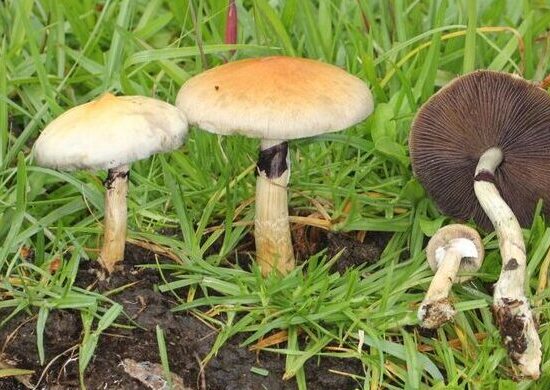Magic mushrooms, also known as psilocybin mushrooms, have intrigued and mystified humans for centuries. Beyond their hallucinogenic reputation, there’s a rich and complex scientific story behind these fungi. In this blog post, we embark on a journey into the science of magic mushrooms, exploring their chemical composition, neurological effects, therapeutic potential, and much more.
The Chemical Magic: Psilocybin and Psilocin
At the heart of magic mushrooms’ enchantment are two closely related compounds: psilocybin and psilocin. Psilocybin, the inactive precursor, gets converted into psilocin in the body, where it exerts its effects.
Chemical Structure: Psilocybin and psilocin are structurally similar to serotonin, a neurotransmitter that plays a crucial role in mood regulation, perception, and cognition. This structural similarity allows them to interact with serotonin receptors in the brain.
Serotonin Receptors: Psilocin primarily binds to serotonin receptors, especially the 5-HT2A receptor. This interaction leads to alterations in thought patterns, mood, and sensory perception.
The Journey Within: Neurological Effects
The consumption of magic mushrooms results in profound changes in consciousness. These effects are largely due to the interaction between psilocin and serotonin receptors in the brain.
Default Mode Network (DMN): The DMN is a network of brain regions associated with self-referential thinking and the “ego.” Psilocin tends to reduce the activity of the DMN, resulting in a state of ego dissolution and a heightened sense of interconnectedness.
Altered Perception: Magic mushrooms can induce alterations in sensory perception, leading to vivid visual hallucinations, changes in sound perception, and a distortion of time.
Emotional Release: Users often report intense emotional experiences, sometimes leading to catharsis, self-reflection, and personal growth.
Therapeutic Potential
Beyond their recreational use, magic mushrooms have shown immense promise as a therapeutic tool in recent scientific research.
Psychedelic-Assisted Therapy: Clinical trials have explored the use of psilocybin in conjunction with psychotherapy to treat conditions such as depression, anxiety, PTSD, and addiction. Psilocybin-assisted therapy can facilitate profound insights and promote emotional healing.
Neuroplasticity: Psilocybin may promote neuroplasticity, the brain’s ability to form new connections. This could be a key mechanism behind the therapeutic effects, as it allows individuals to break free from ingrained thought patterns.
Safety and Set & Setting
While magic mushrooms offer transformative experiences, safety is paramount. Responsible use involves careful consideration of your environment and mental state:
Set & Setting: The mental and physical environment in which you consume magic mushrooms significantly influences your experience. A comfortable, safe, and familiar setting with a trusted trip sitter can enhance your journey.
Dosage: The dosage is crucial; it can mean the difference between a positive experience and a challenging one. Start with a low dose and gradually increase as needed.
Integration: After a magic mushroom experience, integration involves reflecting on and making sense of your insights. Professional therapy or support groups can be valuable in this process.
The Historical and Cultural Context
Magic mushrooms have a rich history of use in various indigenous cultures:
Indigenous Use: Indigenous peoples in different parts of the world have employed magic mushrooms in spiritual and healing ceremonies for centuries. These rituals often involve deep reverence for nature and the interconnectedness of all things.
Modern Resurgence: In recent decades, magic mushrooms have experienced a revival in Western cultures, with growing interest in their potential for personal growth, creativity, and therapy.
Legal Considerations
The legal status of magic mushrooms varies from country to country and even within regions. It’s essential to be aware of local regulations:
Decriminalization: Some places have decriminalized the possession and use of magic mushrooms, while others maintain strict laws.
Medical and Research Use: In certain regions, magic mushrooms are permitted for medical or research purposes, often under strict supervision.
The Future of Magic Mushroom Science
As the stigma surrounding magic mushrooms continues to erode, we can expect more research into their effects and applications:
Ongoing Research: Scientists are conducting studies to further explore the therapeutic potential of magic mushrooms, potentially leading to new treatments for mental health disorders.
Public Awareness: Greater public awareness and acceptance of psychedelics may pave the way for more informed and responsible use.
Conclusion: Unveiling the Magic
The science of magic mushrooms is a captivating journey into the depths of consciousness, brain chemistry, and human potential. While they hold immense promise as a therapeutic tool, their responsible use demands careful consideration of dosage, setting, and legal constraints.
As science continues to reveal the hidden facets of these enigmatic fungi, we find ourselves on the cusp of a new era, one where magic mushrooms may play a pivotal role in reshaping our understanding of the mind, mental health, and human well-being.
Disclaimer: This blog post is for informational purposes only and does not constitute medical or legal advice. Consult with a healthcare professional and be aware of the legal status of magic mushrooms in your area before use.
